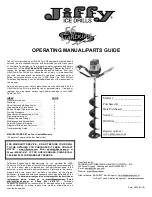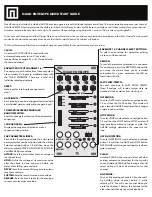
User Manual
V1.0 2017 Copyright SAFEWAZE ™
Page 9
Housing Plate
Housing Plate
Swivel Eye End of Rope
to Anchorage
Free End of Rope at
Tensioner
Housing Plate
Endplate Nut
Tensioning Lever
Cam Anchorage
Attachment Point
Drum of Tensioner
Cam and Lever
Housing Plate Pins
Installation and Use
1.
Loosen endplate nut and Split Housing Plates. Pull back cam and lever and wrap rope around the
drum of the tensioner as indicated related to rope end anchor point. Observe the path of the rope
with regard to both the Cam and the Housing Spacers. Reposition the housing plates, and ensure
the plate sits squarely on the pins. Once aligned, tighten the endplate nut securely to hold the plates
in position.
2.
With a carabiner and cross arm strap, attached the swivel end of the rope to one anchorage and
with the second carabiner secure the cam of the tensioner to the second anchorage. If the tensioner
is installed as indicated, the tail of the rope will hang down and may be used with an automatic rope
grab as a life line for access protection
3.
Pull initial slack through the tensioner by hand, and check that the rope is sitting in the groove of
the drum at this time. If the rope is trapped between the cam and the side of the drum, release the
cam by hand and pull on the rope till it slips back into the center of the drum. It is not necessary to
pull rope till it is fully taught, this is achieved by winding on tension with the tensioning lever.
4.
The rope tensioner can be wound so that the horizontal portion of the lifeline becomes taught
enough to hold and arrest a fall. Do not try to reverse wind the tensioner as the cam will lock and
resist any rotation in this direction. This lifeline requires 400 lbs (200 kg) of force to function optimally.
This may be tested by loading the rope 5 ft (1.5 m) from the tensioner by hand pulling downward on
the lifeline. The sag of the lifeline should not exceed 4 in (100 mm).
































